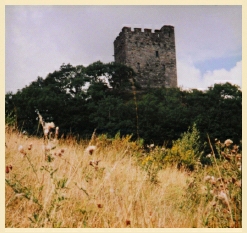Wales and the Marches, 1230 CE:
|
The Age
|
 During the course of the twelfth and thirteenth centuries, the Welsh were ruled by many ruthless and able men: Tywysogion, or Princes. The most forceful and intelligent of these rulers was surely the prince of Gwynedd, Llywelyn ab Iorwerth (d. 1240), whose castle, Dolwyddelyn, is pictured here. Llywelyn was the first Welsh ruler in nearly four hundred years to earn from posterity the cognomen Fawr: the Great. Like his predecessors and contemporaries, Llywelyn had to simultaneously find a way to coexist with his vastly more wealthy and powerful neighbor to the east, and at the same time extend his hegemony over the lesser princes of Wales. The Angevin Kings of England and their marcher barons were powerful and dangerous, and the princes of Wales were quarrelsome and resistant to any of their number who would attempt to impose his authority on the rest. In spite of this volatile political atmosphere, Llywelyn Fawr came closer than any of his predecessors to creating a Welsh polity which could withstand the encroachments of the marcher lords and the impositions of the English King. But it was not an easy task and even Llywelyn the Great had his setbacks. During the course of the twelfth and thirteenth centuries, the Welsh were ruled by many ruthless and able men: Tywysogion, or Princes. The most forceful and intelligent of these rulers was surely the prince of Gwynedd, Llywelyn ab Iorwerth (d. 1240), whose castle, Dolwyddelyn, is pictured here. Llywelyn was the first Welsh ruler in nearly four hundred years to earn from posterity the cognomen Fawr: the Great. Like his predecessors and contemporaries, Llywelyn had to simultaneously find a way to coexist with his vastly more wealthy and powerful neighbor to the east, and at the same time extend his hegemony over the lesser princes of Wales. The Angevin Kings of England and their marcher barons were powerful and dangerous, and the princes of Wales were quarrelsome and resistant to any of their number who would attempt to impose his authority on the rest. In spite of this volatile political atmosphere, Llywelyn Fawr came closer than any of his predecessors to creating a Welsh polity which could withstand the encroachments of the marcher lords and the impositions of the English King. But it was not an easy task and even Llywelyn the Great had his setbacks. |
||
|
In the spring of 1230, Llywelyn's wife Joan, the illegitimate daughter of King John of England, was discovered "in the prince's chamber" with William de Braose, a powerful Anglo-Norman marcher lord. The two were imprisoned and soon William was executed. The affair and the subsequent execution created tensions between Llywelyn and the princes of southern Wales, as well as jeopardizing his good relations with both the royal government and the Braose family with whom Llywelyn had been negotiating a marriage for his son Dafydd. These unresolved tensions and royal inattention ultimately led to the outbreak of war in south Wales in 1231. |
||
|
We would know very little about this episode were it not for the survival in the Public Record Office of a draft for a letter sent by Llywelyn to Stephen de Segrave around midsummer 1230. This letter illuminates the complex dynastic and political problems Llywelyn faced in the wake of William de Braose's execution. The document (PRO SC1/11/58) has long been overlooked because of its very poor state of preservation, but on the following pages I have presented a transcription of it along with several photographs made under ultraviolet light. Click on the fragment of the manuscript pictured at the left to take a closer look at this rare bit of evidence for an obscure but fascinating episode in Welsh and English medieval history. |
Front Page | Intro | Document | Images & Transcription (frames) | Images & Transcription (download) | Transcription Only | Contact | Translation
This web site is copyright ©2000-2006 J. J. Crump except where otherwise noted.

 dultery,
dultery,
 Return to Carrie Home Page
Return to Carrie Home Page